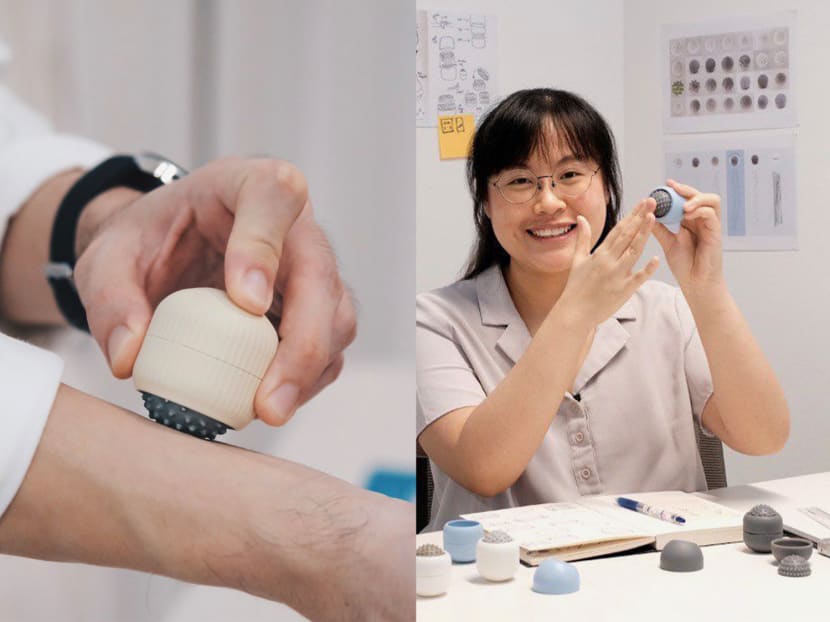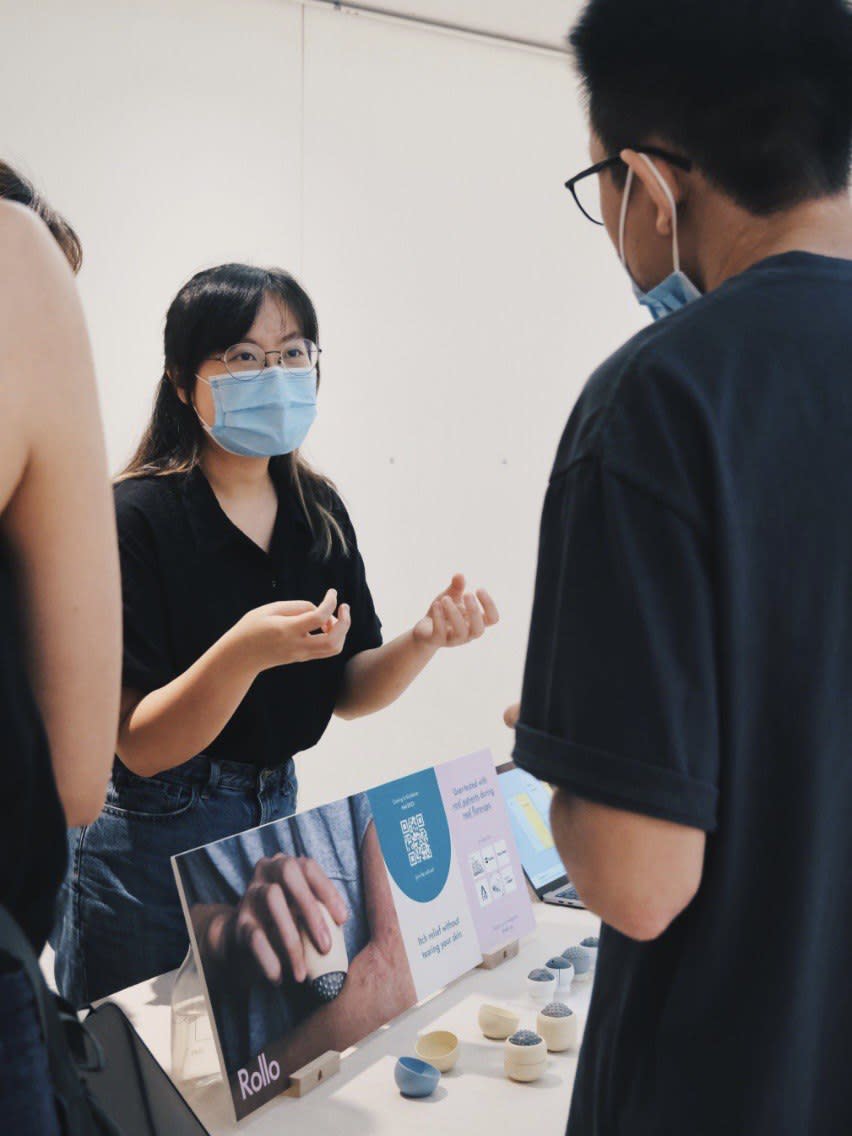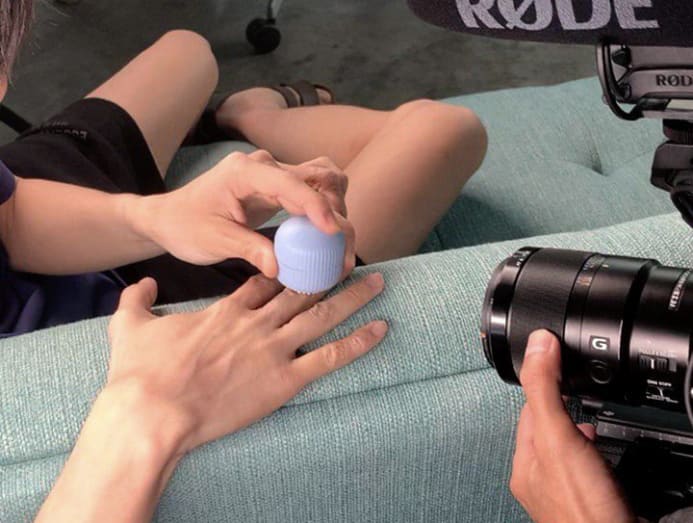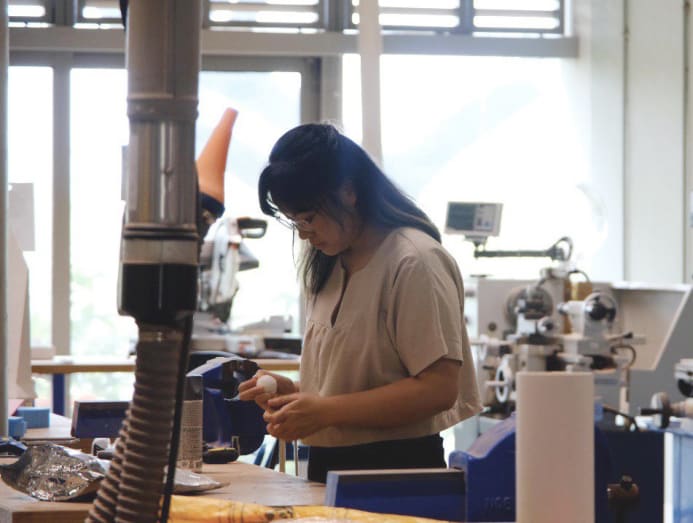This Singaporean invented a rollerball device to relieve eczema itch without hurting the skin. Here's how to get it
Remember the young product designer who won the runner-up prize at the James Dyson Award last year, for her rollerball device for eczema itch? Koh Bei Ning's started manufacturing her invention, now called Rollo, with Kickstarter crowdfunding. CNA Women finds out more.

Koh Bei Ning’s rollerball anti-itch device for eczema skin is becoming a reality with her Kickstarter and website launch. (Photo: Koh Bei Ning)

This audio is generated by an AI tool.
Imagine suffering from eczema and endless itchy skin. And then imagine you create a nifty rollerball device that relieves eczema itch – and it gets picked up by the James Dyson Award for a national innovators contest. Imagine you get so much interest that you crowdfund on Kickstarter to make your rollerball invention a reality.
Koh Bei Ning doesn’t need to imagine. This was her dream and it’s becoming a reality.
Koh suffers from atopic dermatitis (its common name is eczema) and as part of her final-year thesis at the National University of Singapore (NUS) Division of Industrial Design (DID), she created a rollerball itch relief device that works as a gentle alternative to scratching.
She submitted her design as an entry to the James Dyson Award, an international design innovation competition which highlights design engineers at the start of their careers. Her rollerball device became the Singapore runner-up.
Koh’s invention is a rollerball mechanism with a textured ball that rolls over the skin. It uses repetitive downward pressure on itchy skin to provide relief through the texture, while minimising force on the skin.
For sufferers of eczema, this motion reduces tearing of already inflamed and irritated skin and avoids further irritation from fingernails when scratching.
THE ROLLERBALL NOW CALLED ROLLO
Doors opened for her after her invention won accolades, which enabled her to share how her eczema itch relief rollerball, now called Rollo, works.
“I have been given many valuable opportunities such as participating in Prototypes for Humanity, an exhibition in Dubai which gathers 100 student innovations,” she said.
“I was also involved in other exhibitions and events, including the Eczema Support Group Singapore’s event in April. This allowed me to interact with many of their members and share my prototypes in real life,” she added.

In June, Koh launched a crowdfunding campaign for Rollo through funding platform Kickstarter. The campaign, which is now closed, was 123 per cent subscribed, raising over S$100,000 (US$74,960) with the help of 969 backers, mostly from Singapore.
“This amount goes towards funding the production of our first batch of Rollos, made right here in Singapore. If all goes smoothly, our Kickstarter backers will be receiving their Rollo in February 2024,” Koh said.
Once her Kickstarter orders are fulfilled, Koh said she should be able to launch sales on her rollo.sg website.
PREPARING FOR CROWDFUNDING
At the time that Koh entered the James Dyson Award competition, she was part of NUS Design Incubation Centre, under the DID, where she did a one-year incubation programme. The programme aims to support young graduates in developing their ideas into reality.
The programme ended in October but Koh continues to receive assistance from the DIC team, which supported her with further development and preparation for Rollo’s crowdfunding.
“Rollo is a one-woman team. So I’m relying heavily on the support of family and friends on tasks like sorting out logistics and coordinating orders,” she said.

Taking her idea to reality has been both exciting and challenging. “There’s much to learn beyond my background in design, such as how to run a business, manage finances, customer relations and manufacturing timelines.”
A key decision was figuring out Rollo’s positioning – as a lifestyle device or one which was a clinical device.

In preparation for the Kickstarter campaign, the 24-year-old conducted more user testing, explored different materials for the rollerball, such as silicone and metal, before deciding on the final plastic material.
She also met fellow entrepreneurs, medical technology professionals and clinicians. “I even met with teams behind established derma-care brands to explore opportunities and learn about what they do,” she added.
FROM PRODUCT DESIGNER TO ENTREPRENEUR
The transition from product designer to entrepreneur and bringing her idea to the market was a life-changing process.
She said: “Bringing this product to life requires me to understand my responsibility from different perspectives. It is also important that I communicate the position of Rollo clearly as a lifestyle product for itching, and not a clinical or medical product.”
Koh emphasised that claims for Rollo would become more particular if it were the latter.
Taking the crowdfunding approach means relying on an audience that’s taking a leap of faith in me.
What has been hard to face is pushback from those who don’t relate to such a product. “While Rollo received a lot of support from those who suffer from chronic itch and skin conditions, there was scepticism from those who don’t.”
And those people want numbers. Koh found that the product she developed relied heavily on user response and their experiences with itch relief solutions.
However, those qualitative answers don’t answer questions like: “By how many per cent does Rollo relieve one’s itch or reduce harm to the skin?” she said.
That said, Koh is extremely grateful for the opportunity she has been given and even more so the publicity since her product design won recognition through the James Dyson Award.
She credited NUS’ DIC for supporting graduates like herself and providing a conducive space, guidance and income for the year she was with them, to kickstart Rollo.
MORE EMPATHY FOR ECZEMA SUFFERERS
The rigour of preparing her product for the Kickstarter campaign caused Koh to experience a minor flare-up around her lips – after three years. She changed her toothpaste, and avoided spicy and acidic foods.
Through it, she developed more empathy for people suffering from eczema. “It allowed me to expand my knowledge about chronic itch and made me feel more connected to why I started this in the first place,” she said.
“The enthusiastic response and touching stories shared by many made me realise that the struggle (with itch from skin conditions) is perhaps experienced by more than I had imagined.”
Coping with the anticipation from these same people could add pressure but Koh is taking it all in her stride. “Taking the crowdfunding approach means relying on an audience that’s taking a leap of faith in me. They are keen on being a part of this journey because of a common problem.”
PUSHING ROLLO INTO PRODUCTION
Koh’s focus now is ensuring a smooth production process for Rollo’s inaugural batch.
From February 2024, she plans to have a few hundred Rollos available for sale online. According to the Rollo website, pre-orders for the itch relief rollerball, at S$55 per Rollo, are closed until March 2024.
She envisions exploring opportunities for Rollo in the clinical space to expand its role in itch management and make the device more accessible to a wider audience.
“I found that I need to trust myself more in this process. Taking ownership of the project means that I must call the shots and take a stand in moments of a standstill.
“I always thought there was one correct way to build Rollo and was afraid to make mistakes. But ultimately, I learned that one correct answer does not exist – everyone will have their own viewpoint.
“What’s important is I stay true to Rollo’s goals and intentions and do my best to fulfil them.”
CNA Women is a section on CNA Lifestyle that seeks to inform, empower and inspire the modern woman. If you have women-related news, issues and ideas to share with us, email CNAWomen [at] mediacorp.com.sg (CNAWomen[at]mediacorp[dot]com[dot]sg).











